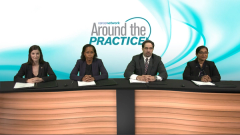
Treatment Considerations for Bispecific Antibodies and Unmet Needs in MM
The expert panel overviews factors to consider with bispecific antibodies and offers closing insights on unmet needs in the multiple myeloma treatment space.
Episodes in this series

Transcript:
Al-Ola Abdallah, MD: Jordan, this is a case that’s unfortunately common. We have to talk about the issue of infection rate, which is very high with [the use of] bispecifics. We’re going to use them more, and we’re not talking about just as a single agent. This is a single agent, by the way. But in combination therapy we’re going to see more than that. With daratumumab there’s an increased risk for infection. If I’m going to use a safer drug, daratumumab is the safest as a combination with teclistamab. We have to talk about the infection rate. What strategy do you believe we need to do? There are many strategies. What strategy do you think we need to decrease the rate of infection so we can get the best benefit with fewer adverse effects?
Jordan Snyder, PharmD: We’ve seen a lot of infections. [That includes] viral infections, opportunistic infections, fungal infections, and PJP [Pneumocystis jirovecii pneumonia] We’ve utilized a couple of strategies for managing these adverse effects. We tend to hold once they become neutropenic and administer growth factor support if they need it. Then you can also consider giving antibiotics and antifungal prophylaxis if you expect prolonged neutropenia.
We keep a very close eye out for hypogammaglobulinemia and replace [when the] IgG level is less than 400 mg/dL. Once we see a response, we’ve started decreasing the frequency of teclistamab from weekly to every other week. We even go so far that once they achieve a CR [complete response], we hold off altogether. We allow them a little time to recover and then resume on progression, which we’ve done on a couple of patients and have had good success with.
Al-Ola Abdallah, MD: I agree. That’s a good approach as well. If the CR is achieved, maybe the durable response will stay for a long period of time. We have less risk for infection, so that’s 1 thing we like to approach for them.
Leyla O. Shune, MD: We know that several bispecifics are approved. How do you choose which 1 to use?... How do you sequence this? How do you go about it?
Al-Ola Abdallah, MD: That’s an interesting question. The same thing happened before. We saw what happened with daratumumab-isatuximab when it came by. How did we make our decision? Why did we choose this 1 over that 1? It’s not about efficacy. It’s about which 1 is more convenient for patients. Let’s say teclistamab and [INAUDIBLE] got approved, which is in the second line. I’m not going to make a conversion between the 2. I’m going to ask our colleagues to meet, make a list of the benefits of using each 1, including reimbursement and how long the duration of stay in the hospital is. All of this is going to play into making our decision. The reason we choose daratumumab is simple: it’s subcutaneous and individually it’s a once a month. That was a reason. It will be the same thing as teclistamab [INAUDIBLE].
I’d save the other targeted therapy if they fail BCMA. That’s my strategy. I agree with Nausheen. If I see a patient refractory to BCMA CAR [chimeric antigen receptor] T cells, I won’t use a BCMA BiTE [bispecific T-cell engager]. I’ll move on to that as my strategy. It’s not strong evidence, but it’s logical to do it. If a patient already failed a BCMA BiTE, I won’t use another BCMA BiTE afterward. It doesn’t make any sense. You have to think how to move to a different target of therapy.
Before we close, I’d like to get some unmet needs and future perspectives from each panelist on the treatment of patients newly diagnosed in relapsed/refractory myeloma. Let’s start with Dr Leyla Shune.
Leyla O. Shune, MD: Another area of need is among patients with high-risk multiple myeloma. They should be taken out and treated with unique combinations. Another area of need that concerns me is plasma cell leukemia. The management of these patients is excluded from most clinical trials. First, how do we define plasma cell leukemia? How do treat plasma cell leukemia? How do we improve on that? These are things I’d like to see [in the future].
Al-Ola Abdallah, MD: I agree. Dr Nausheen?
Nausheen Ahmed, MD: We still have a lot of work to do to get these things out into the community. We still think that patients eligible for CAR T, for example, aren’t reaching the centers that provide the service. I’d like to see [patient] care delivery easier and closer to home, whether it’s CAR T or bispecifics. There’s a lot of movement toward that, but we still have a long way to go. I’m hoping to see more progress on this in the future.
Al-Ola Abdallah, MD: OK. Jordan?
Jordan Snyder, PharmD: It’s an exciting time in the myeloma space. One thing I’d like to see more of is information on sequencing, as we’ve already talked about. We have multiple BCMA agents. Where do they all fall in? Can we move some of these higher up and end up with better progression-free and overall survival? That’s some stuff I’d like to see in the future.
Al-Ola Abdallah, MD: Excellent.… Thank you for watching, and thank you to all our panelists for attending and answering all the questions.
Transcript edited for clarity.
Newsletter
Stay up to date on recent advances in the multidisciplinary approach to cancer.



















































































